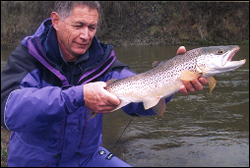Where do trout go?
7/08/2008 |
| Radio tagging trout (Courtesy of Nelson Evening Mail) |
Three strands of research have been used to investigate fish movement patterns: radiotracking of adult trout, trace element analysis of trout otoliths, and PIT tagging of juvenile trout.
The radiotracking study showed that adult trout movements were closely related to flow and water temperature. Some fish moved substantial distances (>50 km) when flows were relatively high and temperatures relatively low, but as summer progressed movement was limited. In the smaller tributary streams, deep pools with good cover provided refuges for adult trout throughout the summer, and once residing in these pools the fish were reluctant (and possibly unable) to leave. A large (1–in–50 year) flood occurred during the study and had a marked effect on adult trout survival with about 65% of the tagged fish being killed by the flood. This study confirmed that substantial movements throughout catchments can occur, but also that adult trout will remain in relatively small streams during low–flow periods as long as there are sufficient refuges.
Key Contact:

|
Roger Young
Email Cawthron Institute Phone: (03) 548 2319 Fax: (03) 546 9464 |
Expertise Land/water interactions, water quality, fisheries, river health |